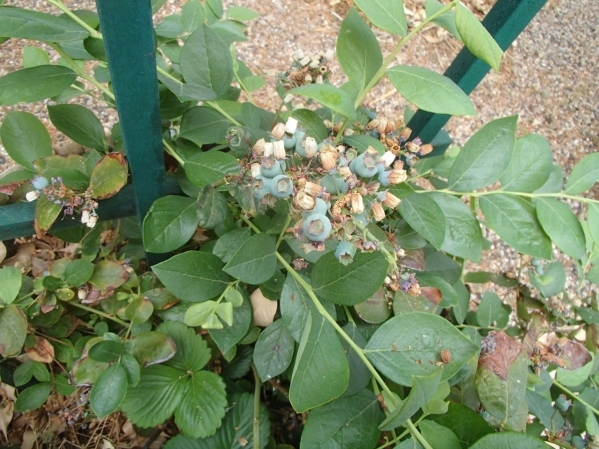Leafhoppers are a nuisance on grapes in Las Vegas



Q: I have a lot of midges or gnats in the leaves of my grape trees. I don’t know what to do to kill them. If I touch the leaves these insects will fly all over me.
A: These are more likely leafhoppers and not gnats or midges. I have had others report these as gnats, too, but after confirming their presence with some pictures they agreed they were leafhoppers.
Leafhoppers are very small and jump rather than fly. There can be hundreds if not thousands right about now on grapes. They cause some leaf yellowing, black specks on the leaves and fruit.
The biggest problem with them is they are a nuisance. They will jump in your face and mouth when you walk by a grapevine. There are some posts on my blog about leafhoppers on grapes.
Not much will work on them now that they are adults except some hard pesticides. You can try soap sprays, but I would not do much until next year. A couple of applications of Spinosad in late April and May to the undersides of leaves and tops will knock the populations back, combined with horticultural oils applications while it is cool in the late spring.
Q: Can you give me any particulars as to growing a fig tree, blueberry bush and strawberries? It would be helpful if you have any information as to the varieties of each.
A: Figs do very well here and any variety will grow. They love this climate. You will get two crops every year if you prune them correctly.
Yellow figs like Kadota are milder in flavor and usually preferred for cooking. The purple and “black” varieties have a stronger flavor and are used for drying, jams and preserves.
Figs will not be productive here without plenty of water, so the biggest mistake people make is not keeping the soil around the roots moist.
Use wood chip surface mulches to preserve soil moisture. Treat them like any other fruit tree except for pruning.
Blueberries are more difficult to grow in our climate and are not a good plant for the desert. People do grow them here and they do produce but require extra care and good gardening techniques. Don’t grow them unless you want to put in the effort.
Grow them in containers or tubs because the soil is easier to manipulate. I discourage people from planting blueberries in this climate unless they are accomplished gardeners. Learn the basics and then you can try exotics like blueberries.
If you simply must have them, then you should have a very high percentage of quality compost in the soil and the soil covered in wood chip mulch. Expose them to as much sun as possible with protection from late afternoon direct sunlight.
Focus your selections on southern highbush types with a low chilling requirement. There have been no trials conducted in our climate, so I can only guess at which varieties to try. Varieties I would look closely at include Misty, Sharpblue, Sunshine Blue and perhaps Southmoon.
Misty is one of the better ones in a desert climate. Your selections should be self-fruitful. The soil will be much easier to manage if adding some acidifying agent such as finely ground soil sulfur, aluminum sulfate or Organic Magic. Organic Magic drops the pH very fast compared to sulfur.
Strawberries are in between these two in difficulty, not as easy as figs and not as difficult as blueberries. They require soils similar to tomatoes for good growth: a well-drained vegetable soil with plenty of compost.
Like any fruit crop, give them as much light as possible but protect them from late afternoon sun. They are shallow-rooted, so water them like you would most vegetables. Fertilize them just after they finish producing, which varies with the strawberry whether it’s an everbearer or main crop type.
Varieties are important. Stay with the everbearing varieties rather than main crop types when selecting for home gardens. Use a surface mulch to keep soils moist and avoid letting the soil get too dry in the summer months.
There is lots of general growing advice on the Internet on things that are not as critical when growing in the desert.
Q: We have seven Mediterranean fan palms in our yard, one of which has an “arm” that will eventually block easy access around that side of the house. Is it harmful to the palm to cut off this arm? If not, is there a time of year that is best to do so? How many “arms” can this type of palm sustain? Is there a suggested maximum?
A: Mediterranean fan palm is meant to be a clumping palm with many side shoots that make a canopy that is a dense, half circle if left undisturbed. Many people will remove some or many of these “arms” to make it more open. In some cases, I have seen all of them removed except for the middle one.
You can cut them back to the ground or even below ground at their point of origin in the clump. In fact, that is the best way to do it. You can do it nearly any time of the year, but during warm weather is best so they heal quickly.
Remove soil from that side and cut it off with a reciprocating saw or handsaw after the blade has been sanitized with alcohol or dilute concoction of 5 percent bleach and water. If using bleach, oil the blade afterward.
Replace the soil after several days when the wound has healed. They are more visually appealing with an odd number of “arms,” so three, five or seven going in different directions and with a balanced canopy is usually the best looking.
Q: My question is about our pampas grass, which is now about 6 or 7 years old. In the beginning, the plumes were white but now are brownish yellow. In fact, they look dirty. I notice, too, most of the plumes are coming on only half of the plant.
A: Pampas grass is native to the grasslands and plains of South America. It has evolved with fire, which is a clue about how to grow it. In the wild, range fires are what keep these things burned to the ground and renewed naturally.
By the way, the standard-size pampas grass is very large and should not be used in landscapes that do not have the room to support its growth. There are dwarf forms of this plant that would be more suitable.
They are a pain in the neck to prune, and some people burn them to the ground every three or four years where burning is permitted. If burning is not permitted, they may be cut to the ground and hauled off. This avoids the problems surrounding fire. Burning or pruning helps renew the plant and keeps its growth more evenly balanced.
When pampas grass first blooms, the plumes may be an assortment of colors depending on the type of pampas grass. After a short time, the flowers may begin to turn an off shade of the same color. At some point, you may not like the color and remove the blooms by cutting them off.
Pampas grass continually puts on new growth from short rhizomes on the periphery of the plant. As it does this, the center usually begins to stop being very productive. In some cases, parts of the plant may die as they get older, larger and overgrown.
Don’t forget to give this plant adequate amounts of water and fertilizer. Apply fertilizers early in the spring prior to new growth and flower development.
— Bob Morris is a horticulture expert living in Las Vegas and professor emeritus for the University of Nevada. Visit his blog at xtremehorticulture.blogspot.com. Send questions to Extremehort@aol.com.


















